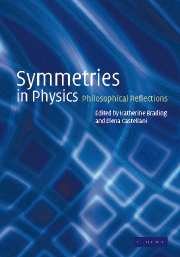Book contents
- Frontmatter
- Contents
- List of contributors
- Preface
- Copyright acknowledgements
- 1 Introduction
- Part I Continuous symmetries
- 2 Classic texts: extracts from Weyl and Wigner
- 3 On continuous symmetries and the foundations of modern physics
- 4 The philosophical roots of the gauge principle: Weyl and transcendental phenomenological idealism
- 5 Symmetries and Noether's theorems
- 6 General covariance, gauge theories, and the Kretschmann objection
- 7 The interpretation of gauge symmetry
- 8 Tracking down gauge: an ode to the constrained Hamiltonian formalism
- 9 Time-dependent symmetries: the link between gauge symmetries and indeterminism
- 10 A fourth way to the Aharonov–Bohm effect
- Part II Discrete symmetries
- Part III Symmetry breaking
- Part IV General interpretative issues
- Index
7 - The interpretation of gauge symmetry
Published online by Cambridge University Press: 08 October 2009
- Frontmatter
- Contents
- List of contributors
- Preface
- Copyright acknowledgements
- 1 Introduction
- Part I Continuous symmetries
- 2 Classic texts: extracts from Weyl and Wigner
- 3 On continuous symmetries and the foundations of modern physics
- 4 The philosophical roots of the gauge principle: Weyl and transcendental phenomenological idealism
- 5 Symmetries and Noether's theorems
- 6 General covariance, gauge theories, and the Kretschmann objection
- 7 The interpretation of gauge symmetry
- 8 Tracking down gauge: an ode to the constrained Hamiltonian formalism
- 9 Time-dependent symmetries: the link between gauge symmetries and indeterminism
- 10 A fourth way to the Aharonov–Bohm effect
- Part II Discrete symmetries
- Part III Symmetry breaking
- Part IV General interpretative issues
- Index
Summary
Introduction
The term ‘gauge’ refers in its most general everyday connotation to a system of measuring physical quantities, for example by comparing a physical magnitude with a standard or ‘unit’. Changing the gauge would then refer to changing the standard. The original idea of a gauge as introduced by Weyl in his (1918) in an attempt to provide a geometrical interpretation of the electromagnetic field was to consider the possibility of changing the standard of ‘length’ in a four-dimensional generalization of Riemannian geometry in an arbitrary local manner, so that the invariants of the new geometry were specified not just by general coordinate transformations but also by symmetry under conformal rescaling of the metric. The result was, in general, a non-integrability or path dependence of the notion of length which could be identified with the presence of an electromagnetic field. In relativistic terms this meant that, unacceptably, the frequencies of spectral lines would depend on the path of an atom through an electromagnetic field, as was pointed out by Einstein.
With the development of wave mechanics the notion of gauge invariance was revived by Weyl himself (1929) following earlier suggestions by Fock and by London, so as to apply to the non-integrability of the phase of the Schrödinger wave function, effectively replacing a scale transformation eα(x) by a phase transformation eiα(x).
- Type
- Chapter
- Information
- Symmetries in PhysicsPhilosophical Reflections, pp. 124 - 139Publisher: Cambridge University PressPrint publication year: 2003
- 13
- Cited by

